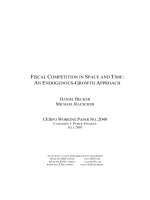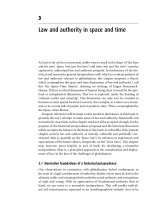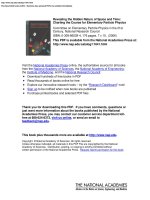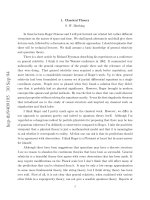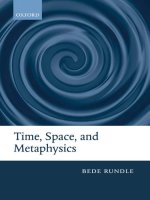Children discourse person space and time across languages
Bạn đang xem bản rút gọn của tài liệu. Xem và tải ngay bản đầy đủ của tài liệu tại đây (7.2 MB, 412 trang )
Free ebooks ==> www.Ebook777.com
www.Ebook777.com
Free ebooks ==> www.Ebook777.com
This page intentionally left blank
www.Ebook777.com
C H I L D R E N’S DISC OUR S E
PERSON, SPACE AND TIME ACROSS LANGUAGES
This original comparative study explores two central questions in the study
of first language acquisition. What is the relative impact of structural and
functional determinants? What is universal versus language-specific during
development? Maya Hickmann addresses these questions in three domains of
child language: reference to entities, the representation of space, and uses of
temporal-aspectual markings. She provides a thorough review of different theoretical approaches to language acquisition and a wide range of developmental
research, as well as examining all three domains in English, French, German
and Chinese narratives. Hickmann’s findings concern the rhythm of acquisition, the interplay among different factors (syntactic, semantic, pragmatic)
determining children’s uses, and universal versus variable aspects of acquisition. Her conclusions stress the importance of relating sentence and discourse
determinants of acquisition in a cross-linguistic perspective. Children’s Discourse will be welcomed by those working in psychology and language-related
disciplines interested in first language acquisition.
is Research Director at Laboratoire Cognition et
D´eveloppement, Centre National de la Recherche Scientifique and University of Paris V. Her publications on discourse include a variety of chapters in
collected volumes and articles in journals concerning first language acquisition including Journal of Child Language, First Language and Journal of
Psycholinguistic Research. She is also the editor of Social and Functional
Approaches to Language and Thought (1987).
In this series
60
61
62
63
64
65
66
67
68
69
70
71
72
73
74
75
76
77
78
79
80
81
82
83
84
85
86
87
88
89
90
91
92
93
94
95
96
97
98
. . : The syntax and semantics of middle constructions: a study
with special reference to German
. : Universal grammar and language learnability
. : A-Morphous morphology
: Switch reference and discourse representation
. : A theory of aspectuality: the interaction between temporal and
atemporal structure
. : The lexicon in acquisition
. : English auxiliaries: structure and history
. . : Grammatical theory in the United States from Bloomfield to
Chomsky
: Negative and positive polarity: a binding approach
. . . : Ergativity
: The syntax and pragmatics of anaphora
: Information structure and sentence form: topic, focus, and the
mental representations of discourse referents
: Principles of English stress
. : A performance theory of order and constituency
. : Historical syntax in cross-linguistic
perspective
: The syntax of negation
: Syntax and parsing
: Italian syntax and universal grammar
: Restrictiveness in case theory
. : Intonational phonology
: The raising of predicates: predicative noun phrases and the theory
of clause structure
: Historical linguistics and language change
. : A notional theory of syntactic categories
: Possession: cognitive sources, forces and grammaticalization
-: The dynamics of focus structure
: Phonological representations: their names, forms and powers
. : Slavic prosody: language change and phonological theory
: Conditionals and prediction: time, knowledge and
causation in conditional constructions
: Creole genesis and the acquisition of grammar: the case of
Haitian Creole
: Lexical strata in English: morphological causes, phonological
effects
: Morpheme order and semantic scope: word formation and the
Athapaskan verb
. .. : Lexical phonology and the history of English
. : Tone sandhi: patterns across Chinese dialects
. : Inflectional morphology: a theory of paradigm structure
: Phonology and language use
: Morphological productivity
: The Syntax of adjuncts
and . : Regularity in
semantic change
: Children’s discourse: person, space and time across languages
Earlier issues not listed are also available
Free ebooks ==> www.Ebook777.com
C A M B R I D GE S T UDIE S IN L INGUISTI CS
General editors: . , . , . ,
. , . . , . , . ,
. , . , . .
Children’s Discourse
www.Ebook777.com
C HI L DR E N’S
DI SC O U R S E
PERSON, SPACE AND TIME
ACROSS LANGUAGES
MAYA HICKMANN
Centre National de la Recherche Scientifique,
Universit´e Ren´e Descartes, Paris
The Pitt Building, Trumpington Street, Cambridge, United Kingdom
The Edinburgh Building, Cambridge CB2 2RU, UK
40 West 20th Street, New York, NY 10011-4211, USA
477 Williamstown Road, Port Melbourne, VIC 3207, Australia
Ruiz de Alarcón 13, 28014 Madrid, Spain
Dock House, The Waterfront, Cape Town 8001, South Africa
© Maya Hickmann 2004
First published in printed format 2002
ISBN 0-511-03984-0 eBook (netLibrary)
ISBN 0-521-58441-8 hardback
Contents
List of figures
List of tables
Preface
List of abbreviations and conventions
page x
xiv
xv
xvii
1
Introduction
1.1
1.2
1.3
Acquiring language
Domains of child language
Overview of contents in subsequent chapters
1
1
11
17
19
2
Theoretical issues
2.1
2.2
2.3
Some main theoretical issues in theories of language acquisition
Functional approaches to language
Functional aspects of reference in cohesive discourse
21
21
37
43
3
Cross-linguistic invariants and variations
3.1
3.2
3.3
3.4
3.5
Some general typological dimensions
Denoting entities
Space
Time
Summary
4
Coherence and cohesion in discourse development
4.1
4.2
4.3
Macrostructures
Emergence of the textual function
Summary
49
49
56
67
77
84
86
86
101
105
vii
Free ebooks ==> www.Ebook777.com
Contents
5
Children’s marking of information status: referring
expressions and clause structure
5.1
5.2
5.3
Referring expressions
Clause structure in discourse
Summary
6
The acquisition of spatial and temporal-aspectual
devices
6.1
6.2
6.3
Motion and location
Temporal-aspectual markings
Summary
141
141
154
169
-
173
7
Methodological issues
7.1
7.2
Control of relevant variables
Design of the present study
8
Animate entities
8.1
8.2
8.3
Referent introductions
Reference maintenance
Summary and discussion
9
Space
9.1
9.2
9.3
9.4
9.5
Situation types
Explicitness of spatial grounds
Spatial anchoring
Maintaining reference to spatial grounds
Summary and discussion
10
Time
10.1
10.2
10.3
10.4
Distribution of all temporal-aspectual devices
Impact of predicate types on verbal devices
Discourse determinants of temporal-aspectual devices
Summary and discussion
11
Conclusions
11.1
11.2
11.3
Summary of findings in each domain
General conclusions across domains
Implications and concluding remarks
viii
www.Ebook777.com
108
108
134
139
175
175
183
194
194
207
230
240
240
249
257
274
276
282
282
290
294
314
318
318
324
334
Contents
Appendix
Notes
References
Author index
Subject index
343
345
350
383
388
ix
Figures
8.1
8.2
8.3
8.4
8.5
8.6
8.7
8.8
8.9
8.10
x
First mentions of characters with appropriate local markings
of newness. From Hickmann, Hendriks, Roland and Liang
1996. Reprinted with permission from Cambridge
University Press.
page 196
Classifier use in Chinese first and subsequent mentions of
characters. From Hickmann, Hendriks, Roland and Liang
1996. Reprinted with permission from Cambridge
University Press.
198
First mentions and subsequent mentions of characters in
postverbal position. From Hickmann, Hendriks, Roland and
Liang 1996. Reprinted with permission from Cambridge
University Press.
199
Types of clause structures used for the first mentions of
characters
202
Types of clause structures used for first mentions of characters
across ages: (a) Postverbal first mentions,
(b) Preverbal first mentions
203
First mentions of characters as a function of position and local
newness markings. From Hickmann, Hendriks, Roland and
Liang 1996. Reprinted with permission from Cambridge
University Press.
206
Lean forms in reference maintenance to characters. From
Hickmann and Hendriks 1999. Reprinted with permission
207
from Cambridge University Press.
Different forms used in reference maintenance to characters
208
Different forms used in reference maintenance to characters as
a function of age
210
Lean forms used for each character of the HORSE story. From
Hickmann and Hendriks 1999. Reprinted with permission
from Cambridge University Press.
211
List of figures
8.11
8.12
8.13
8.14
8.15
8.16
8.17
8.18
8.19
8.20
8.21
8.22
8.23
8.24
8.25
9.1
9.2
9.3
9.4
Lean forms used for each character of the CAT story. From
Hickmann and Hendriks 1999. Reprinted with permission
from Cambridge University Press.
Overall relation between the position and form of subsequent
mentions. From Hickmann and Hendriks 1999. Reprinted with
permission from Cambridge University Press.
Overall relation between the semantic role and position of
subsequent mentions
Overall relation between the semantic role and form of
subsequent mentions
Overall relation between the grammatical role and form of
subsequent mentions
Overall relation between coreference and the form of
subsequent mentions
Percentages of coreferential NPs within each form type. From
Hickmann and Hendriks 1999. Reprinted with permission
from Cambridge University Press.
Grammatical role and coreference within each form type
Relation between the grammatical role and form of
coreferential subsequent mentions across ages. From
Hickmann and Hendriks 1999. Reprinted with permission
from Cambridge University Press.
Types of coreferential subsequent mentions overall
Types of coreferential subsequent mentions across ages. From
Hickmann and Hendriks 1999. Reprinted with permission
from Cambridge University Press.
Types of coreferential subsequent mentions within each form
type overall
Pronominal and nominal subsequent mentions in SS relations
for each character in the HORSE story
Pronominal and nominal subsequent mentions in SS relations
for each character in the CAT story
Types of coreferential subject pronominals. From Hickmann
and Hendriks 1999. Reprinted with permission from
Cambridge University Press.
Overall distribution of predicate types
Ambiguous mentions of spatial grounds
Overall explicit mentions of spatial grounds
Explicit mentions of spatial grounds as a function of
predicate types
212
213
215
216
217
219
220
221
222
223
224
225
226
227
228
242
250
252
254
xi
List of figures
9.5
9.6
9.7
9.8
9.9
9.10
9.11
9.12
9.13
9.14
9.15
9.16
9.17
9.18
9.19
9.20
10.1
10.2
10.3
10.4
10.5
10.6
10.7
10.8
10.9
xii
German sentence-initial pronominal adverbials
First mentions of spatial grounds with local newness
markings
Forms and positions of Chinese first mentions of
spatial grounds
Predicates used for the first mentions of spatial
grounds overall
Predicates and NP types used for the first mentions of spatial
grounds as a function of age
First mentions of spatial grounds in locative role across ages
Semantic roles and forms of the first mentions of
spatial grounds
Local newness markings with locative vs. non-locative first
mentions of spatial grounds across ages
Local newness markings with first mentions of spatial grounds
within each semantic role
Early spatial anchoring, late first mentions, and omissions as a
function of age
Forms of early spatial anchors in the CAT and HORSE
stories overall
Forms of early spatial anchors across ages
Nominal subsequent mentions of spatial grounds across ages
Predicate types used for the subsequent mentions of
spatial anchors
Locative subsequent mentions of spatial anchors
Coreferential mentions of spatial anchors across ages
Overall proportions of past inflections
Uses and non-uses of aspect particles in Chinese
Different uses of the aspect particle le in Chinese
Proportions of regional connectives across ages
Temporal-aspectual markings used with regional connectives
Most frequent temporal-aspectual markings used with regional
connectives across ages
Proportions of past and/or perfective markers with bounded
vs. unbounded predicates. From Hickmann 1996. Reprinted
with permission from Lawrence Erlbaum.
Overall temporal anchoring in English, French, and German
HORSE stories
Overall temporal anchoring in English, French, and German
CAT stories
257
258
260
261
262
263
264
265
266
271
272
273
274
275
276
277
284
285
286
289
291
292
293
298
299
List of figures
10.10
10.11
10.12
10.13
10.14
10.15
10.16
10.17
10.18
10.19
Temporal anchoring in English, French, and German
across ages
Overall temporal anchoring in English, French, and German
mixed HORSE stories
Overall temporal anchoring in English, French, and German
mixed CAT stories
Temporal anchoring in English, French, and German mixed
narratives across ages
Discourse contexts of temporal-aspectual shifts overall
Most frequent discourse contexts of temporal-aspectual shifts
across ages
All temporal-aspectual shifts marking a grounding distinction
Temporal-aspectual shifts in Chinese overall
Temporal-aspectual shifts across ages in Chinese
Inflection and particle shifts marking situational overlaps in
the CAT story. From Hickmann 1996. Reprinted with
permission from Lawrence Erlbaum.
300
301
302
303
305
306
307
312
313
314
xiii
Tables
3.1
4.1
4.2
4.3
4.4
5.1
5.2
7.1
9.1
9.2
9.3
9.4
9.5
9.6
10.1
10.2
10.3
xiv
Impact of aspect on the interpretation of temporal relations
among events
Example of canonical story (Stein and Glenn 1979)
Example of canonical story (Mandler 1978)
Example of canonical story (Hickmann and Schneider 2000)
Summary of all experimental conditions (Hickmann and
Schneider 2000)
Example of canonical story (Hickmann and Schneider, 1993)
Summary of all experimental conditions (Hickmann and
Schneider, 1993)
Samples of subjects in the study
Packaging of information in dynamic predicates: French
Packaging of information in dynamic predicates: English
Packaging of information in dynamic predicates: German
Packaging of information in dynamic predicates: Chinese
Presentative constructions used with each predicate type in
French and Chinese
Postverbal introductions of inanimate referents serving
as grounds
Verbal inflections in the Indo-European languages
Uses and non-uses of Chinese aspect markers within
each narrative
Connectives as a function of inflections and particles
page 84
89
90
99
100
130
130
186
244
244
245
245
255
259
283
287
290
Preface
The aim of this book is to explore two questions in the study of first language
acquisition: the role of structural and functional determinants during acquisition,
and the extent to which the developmental process is invariant vs. variable across
languages. In order to address these questions, I examine within a functional and
cross-linguistic perspective the acquisition of a variety of linguistic devices relevant to three domains of child language: the denotation of entities, the expression
of motion and location, and the marking of temporal-aspectual distinctions. In relation to the first question, my aim is to determine the relative impact of two types
of factors during language acquisition: syntactic and semantic factors that operate at the sentence level; and discourse pragmatic factors that operate beyond the
sentence, particularly those that regulate the flow of information across utterances
as a function of presupposition and focus in discourse. Furthermore, the book is
framed within a comparative perspective, in which evidence from different languages is repeatedly brought to bear on the second question, in light of various
claims concerning universal vs. language-specific determinants of acquisition.
After an introduction presenting the general aims of the book, subsequent chapters
are divided into two parts. The first part provides a general theoretical background
and overview of the relevant developmental literature. After a discussion of the
methodological issues arising from this literature, several chapters in the second part
then present the results of a study comparing narrative productions of children and
adults in four languages (French, English, German and Mandarin Chinese). The last
chapter argues that models that focus exclusively on the sentence or discourse levels
of linguistic organisation and/or ignore cross-linguistic evidence are misleading. My
conclusion stresses the crucial role of multifunctionality during language acquisition
and the necessary inclusion of this fundamental property of human language for an
adequate account of the developmental process in a cross-linguistic perspective.
Some specific questions are addressed to specialists, but my intention is also
to provide a wider audience with an updated introduction to cross-linguistic functional approaches to language acquisition. Although developmental psycholinguistics has considerably expanded during the twentieth century, resulting in a striking
proliferation of theories, of methodologies, and of results, this field is now in serious
xv
Preface
need of fresh attempts to relate sentence and discourse determinants of acquisition
across languages. Given this ambition, some deliberate choices were obviously
necessary. Although the book is centrally concerned with the relation among forms
and functions in language acquisition, not all facets of this relation are discussed.
Some aspects of linguistic structure are only touched upon, even though they clearly
have an impact on a number of linguistic phenomena investigated here. In addition,
I purposefully focus on only one set of functional determinants, namely pragmatic
principles governing information flow within cohesive discourse. I give reasons
throughout to justify these choices, pointing out areas that deserve more research.
The empirical contribution of this book stems from a large project I began as a
member of the Max-Planck Institute for Psycholinguistics in Nijmegen (1981–92).
The collaboration of J¨urgen Weissenborn (University of Potsdam) allowed the constitution of the German corpus. The Chinese corpus resulted from an exchange
programme between Nijmegen and Peking, set up through the friendly and efficient
labour of James Liang (University of Leiden) and the generous collaboration of
Professors Xu and Ye (University of Peking). Subsequent financial support was
provided by the Deutsche Forschungsgemeinschaft (Schwerpunkt ‘Spracherwerb’
1988–94), by the Max-Planck Institute for Psycholinguistics (1994–5), and by an
exchange programme (1995–97) jointly financed by the Max-Planck Gesellschaft
in Germany and the Centre National de la Recherche Scientifique in France.
This support allowed the project to expand considerably into several domains and
theoretical directions, as well as to develop a rigorous coding method suited to
large cross-linguistic databases, which is now used by many colleagues in several
countries.
I have had three main collaborators throughout: James Liang, to whom I owe many
insights about Chinese; Fran¸coise Roland, who made invaluable contributions to
the analyses; and Henri¨ette Hendriks, who co-ordinated all phases of the research
with me. Several assistants joined us for shorter periods of time, contributing to
the lively and endless work of coding: Justine Cassell, Maghiel van Crevel, Xu
Ding, Lydia Humblot, Birgit Kaiser, Li Ping, Brigitte L¨obach, Ester Messing, and
Caroline Rek. I am also indebted to Madeleine L´eveill´e for her patient and devoted
technical help with programming and formatting. Much of my inspiration came
from stimulating discussions with members of the Max-Planck Institute throughout
the years: Melissa Bowerman, Werner Deutsch, Wolfgang Klein, Clive Perdue, and
J¨urgen Weissenborn. I am indebted to Ruth Berman and Dan Slobin for constant
encouragement and readiness to listen. Especially warm thanks go to Wolfgang
Klein for his continuous support throughout.
Maya Hickmann
xvi
Abbreviations and conventions
Whenever necessary, literal and free translations of examples are provided. Free
translations are somewhat arbitrary with respect to categories not encoded in a given
language (e.g. tense in Chinese). Whenever relevant, the following conventions
are used in examples in addition to those explicitly glossed in the text (except in
examples that are quoted from another source): (1) for number, gender, and case; (2)
for word order; (3) for temporal-aspectual morphology; (4) additional conventions
specific to Chinese.
(1) SG singular
PL plural
FEM feminine
MASC masculine
NEU neuter
NOM nominative
ACC accusative
DAT dative
GEN genitive
(2) SOV Subject-Object-Verb
SVO Subject-Verb-Object
SSVO left-dislocated subject with coreferential pronoun
(3) English
PR present
PRPG present progressive
PRT preterite (past non-progressive)
PAPG past progressive
PRPERF present perfect
PAPF past perfective (pluperfect)
PG untensed progressive
French
PR pr´esent
IMP imparfait
xvii
Free ebooks ==> www.Ebook777.com
List of abbreviations and conventions
PC pass´e compos´e
PS pass´e simple
PQP plus-que-parfait
German
PR Pr¨asens
PTT Pr¨ateritum
PFK Perfekt
PQP Plusquamperfektum
(4) Chinese
1 to 4 tones
3p third person pronoun
CL classifier, distinguished when necessary as SCL (specific classifier)
vs. GCL (general classifier)
IMP imperfective marker
POS possessive marker
PCL particles
Some Chinese particles are not translated (e.g. le, ba3, and gei3 are
simply indicated as LE, BA, and GEI).
xviii
www.Ebook777.com
1
Introduction
Two questions are central to the psycholinguistic study of first language acquisition.
What structural and functional factors determine the acquisition process? What are
universal and language-specific aspects of this process? This introductory chapter
first presents the general theoretical thrust adopted in this book to address these two
questions (Section 1.1). Particular attention is placed on the distinction between
the forms and functions of language, the need to relate the sentence and discourse
levels of linguistic organisation, and the importance of cross-linguistic comparisons
for the study of language acquisition. I then indicate more specific developmental
questions that arise in three domains of language to be examined thoroughly in
this book: reference to entities, the expression of motion and location, and temporal
organisation in discourse (Section 1.2). Finally, this chapter closes with an overview
of the contents to be found in subsequent chapters (Section 1.3).
1.1 Acquiring language
First language acquisition is a complex process involving two facets:
all children acquire the type of semiotic system that is characteristic of our species
(human language), while acquiring the particular language that surrounds them
(their native language). Providing an adequate account of both facets is perhaps the
most difficult puzzle to be solved by theories of language acquisition. The central
developmental argument put forth in this book is twofold and can be summarised
as follows. First, regardless of their particular native language, children’s main task
is to relate the forms and functions of language (Section 1.1.1). Second, some
aspects of this universal process are nonetheless variable across languages, because
the properties of the particular systems with which children are confronted can
influence the course of development (Section 1.1.2). I briefly introduce below each
part of the argument, contrasting the functional view adopted here with other views
that make very different assumptions.
Introduction
1.1.1 Acquiring the forms and functions of language
A central claim of the functional approach adopted here is that children’s main task during language acquisition is to map onto each other sets of
linguistic units that have particular formal structural properties and the multiple
functions that can be served by these units in communication. As a result, children
acquire an intricate system of forms and functions, which implies multiple relations at different levels of linguistic organisation. At this point, it may be of some
use to illustrate different views of language in order to highlight what underlying
questions arise when we attempt to relate forms and functions. As will be shown,
some approaches focus mostly on formal aspects of language, whereas others focus
mostly on functional aspects, and little is yet known about how to relate these two
aspects of language development. These different foci have resulted in a theoretical
gap concerning the determinants of language acquisition and have raised methodological questions concerning adequate units of analysis. In particular, I illustrate in
this chapter aspects of language that cannot be analysed exclusively on the basis of
formal properties of the sentence level, requiring recourse to functional properties
at the discourse level. Subsequent chapters will also discuss some formal correlates
of functional principles of linguistic organisation and show how an adequate functional account requires a consideration of general and variable aspects of language
structure.
1.1.1.1 Forms vs. functions
Throughout the book, I use the term linguistic form as a non-technical
shorthand for different types of formal units in language. These units include the
smallest building blocks of linguistic stuff at the phonological level (with which we
will not be centrally concerned in this book), the unit of the clause (roughly encoding
a proposition), the unit of the sentence (which may contain several clauses), different
types of intermediary units constitutive of clauses and of sentences (e.g. verbal or
nominal morphology, prepositions, particles, noun phrases, verb phrases, and so on),
and larger discourse units that go beyond isolated sentences and involve a relation
between utterances and their contexts. Depending on one’s theoretical viewpoint,
such units might be defined in different ways, each of which has consequences for
our understanding of language and its development. In some theories, they might
be defined strictly in formal structural terms, considered to be the essence of human
language and to be available to children at birth. In other theories, the semantic and
pragmatic properties of linguistic units are central, and they are viewed as providing
a powerful mechanism for developmental change.
Consider some aspects of the acquisition of verbal morphology. As will be shown
later on (Chapters 5 and 6), particular developmental patterns can be observed as
Acquiring language
children gradually acquire various morphological markings, such as the English
markings for third person (-s), past tense (-ed), or progressive aspect (-ing). Such
patterns might include the presence or absence of particular markings and/or of different types of errors at particular points, which might lead to various conclusions
concerning the acquisition process. The interpretation of the results might differ a
great deal depending on one’s approach to language. For example, one might view
the emergence of these forms as exclusively reflecting grammatical knowledge,
for example as showing children’s discovery of finiteness, which provides evidence
for subject-verb agreement and therefore for their reliance on the formal category
Subject. Such a view leads to further predictions concerning co-occurrences between finiteness and other aspects of child language, for example the presence or
absence of null elements within and across languages (see further discussions in
Chapters 2 and 3). According to other views, however, the emergence of these forms
reflects children’s reliance on semantic and/or pragmatic categories, which must be
related to other aspects of development: their developing ability to use linguistic
devices to explicitly differentiate participants from non-participants in the speech
situation, to mark the ongoing nature of events or their results, or to temporally
relate denoted events to speech time or to other events that are denoted in discourse.
More generally, theories diverge with respect to what aspect of language is most
fundamental. For example, Chomsky’s (1981) theory of Universal Grammar views
language as a structure defined by general and particular formal properties, regardless of whatever (system-external) functions it might serve. This structure is innate
and as such it is therefore not ‘acquired’: developmental change is seen as resulting
either from sheer maturation or from a number of factors, including the alleviation
of constraints due to an immature cognitive system (‘processing’ or ‘performance’
constraints) and ‘discovery procedures’, whereby children determine the properties
of the particular system that surrounds them. In contrast, functional theories view
first language acquisition as a process whereby children learn linguistic devices as
‘tools’ to help reach particular communicative goals. That is, linguistic forms are not
acquired ‘for their own sake’, so to speak, but because they serve crucial functions
when we communicate with others. Such functions include the encoding of propositional content in our messages, such as the expression of semantic relations within
sentences (who did what to whom, when and where). They also include relating
our messages to the immediate linguistic and non-linguistic context of utterance,
which allows propositional content to be constructed in cohesive discourse (e.g.
as a function of what is mutually known, most presupposed, in focus) and social
relations to be secured in the discourse situation (e.g. what is socially appropriate in
relation to role relations among the interlocutors). All of these functions of language
constitute a major driving force in development, providing a dynamic mechanism
for why and how children acquire language. A number of recent models, including
Introduction
the one to be proposed in this book, now attempt to provide explanations in which
development is centrally determined by functional factors, while making room for
complex innate predispositions and endogenous processes. Such views acknowledge the role of structural factors in determining some patterns of development that
are characteristic of human language acquisition, as well as some patterns that are
specific to the particular language to be learned.
1.1.1.2 Sentences vs. discourse
Related to the distinction between form and function is the existence
of two levels of organisation in language: the sentence level and the discourse level.
Theories diverge fundamentally with respect to which level they take to be most
central. Correspondingly, some consider that the most fundamental basic unit of
analysis is (maximally) the sentence, while others consider that the basic unit is discourse, requiring that we necessarily go beyond the sentence to include (minimally)
an intrinsic relation between utterances and their context of use.1 Implicit in this
choice is a focus on different aspects of language, such as the syntactico-semantic
properties of linguistic devices within the sentence or their pragmatic properties in
discourse. Examples (1.1) to (1.8) illustrate these different theoretical foci. Within
a first type of approach, the sentence is a necessary and sufficient unit of analysis to
determine a number of crucial properties of language, such as role relations among
noun phrases (hereafter NPs) and uses of reflexive pronouns. In the absence of
context, it is possible to determine in (1.1) and (1.2) which NPs are subject (John,
he) vs. object (Peter, him). It is also possible to specify possible and impossible
coreference relations within sentences: the pronoun him in (1.3) and in (1.4), as
well as the pronoun he in (1.7) cannot refer to John; the pronoun himself can only
refer to John in (1.5) to (1.7) (and it is obligatory in these cases); the pronouns he
and himself in (1.8) must denote the same referent, either John or some referent
not identified in the sentence (see further details in Chapter 3).
(1.1)
(1.2)
(1.3)
(1.4)
(1.5)
(1.6)
(1.7)
(1.8)
John washed Peter.
He washed him.
John washed him.
Peter said that John washed him.
John washed himself.
Peter said that John washed himself.
He said that John washed himself.
John said that he washed himself.
This first type of approach, then, provides powerful principles accounting for
various types of sentence-internal relations. However, it cannot account for many
Acquiring language
other aspects, particularly those that depend on a relation between the sentence
and context. Thus, it cannot account for why non-reflexive pronouns rather than
nominal forms are used in (1.2) (he, him), in (1.3) (him), in (1.4) (him, when it does
not refer to Peter), in (1.7) (he), and in (1.8) (he, when it does not refer to John).
Furthermore, determining which particular entity is picked out depends on relations
that are established within discourse between the pronouns and some previous form
introducing the referents or on mutual knowledge established in other ways (e.g.
because the referents are present in the immediate non-linguistic context or are
otherwise familiar). More generally, with most of the sentences we produce, and
regardless of whether they contain proper names (Peter), definite expressions (the
boy), or pronouns (he), the sentence level of analysis cannot account for how the
interlocutor is to retrieve the identity of the denoted referents in the context of
utterance. As will be shown, these problems are pervasive in language, applying to
other domains of language, such as the expression of time and space.
Such problems are at the heart of functional pragmatic approaches, which consider that the basic unit of analysis must go beyond the sentence and postulate that
context-dependence is a fundamental inherent property of language. In this respect,
context contributes to mutual knowledge, a complex notion that has been characterised in terms of a number of dimensions affecting the ‘accessibility’ of referents in
the universe of discourse (whether their existence and identity are mutually known,
whether they are attended to, salient or otherwise familiar from previously established background knowledge, etc.). Consider examples (1.9) to (1.13), in which
sentences containing third person reflexive and non-reflexive pronouns are preceded
by a context sentence. Although the context sentence is superfluous to specify why
the reflexive himself is used in (1.9), it contributes in accounting for the uses vs.
non-uses and interpretations of the non-reflexive pronouns he, her, and him in all
examples (for further details, see Chapter 3). All other things being equal and in the
absence of competing referents in the context, the clauses he told him/her would
typically be interpreted as involving a subject pronoun he that refers to Peter and
object pronouns him or her that refer to John or Mary, respectively. Several factors
converge towards such a preferred interpretation: the fact that the two NPs Peter and
he are both in subject role across successive clauses, making a coreference relation
most likely to be established between them; gender markings, which exclude some
coreference relations; the semantics of the main predicates, that is, the nature and
relatedness of the verbs reassure and say; and the fact that Peter constitutes the topic
of discourse. However, other interpretations are possible, particularly in relation to
the context of this two-sentence universe in which the existence and identity of other
referents are assumed. All the non-reflexive pronouns could also denote external
referents and, indeed, some such referents must be involved in examples (1.12) (the
referent of her) and (1.13) (the referent of him).
